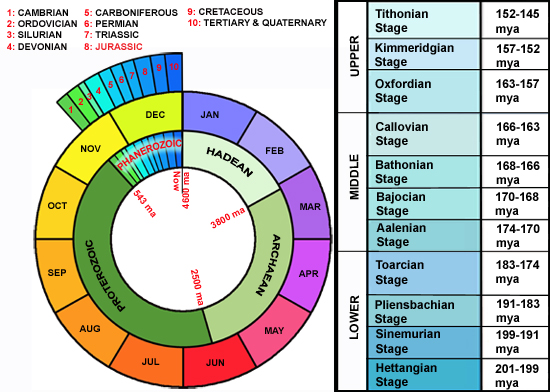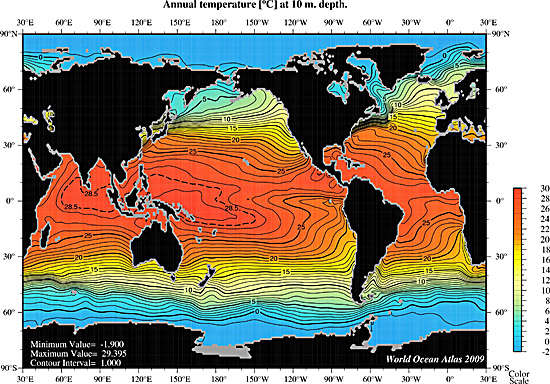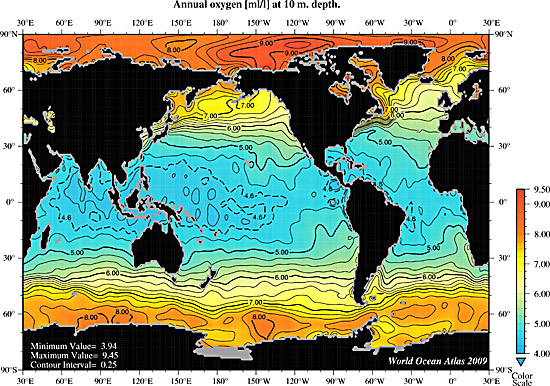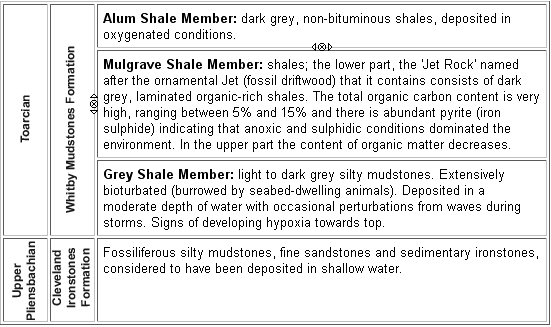
New research links greenhouse gas-related global warming to severe environmental degradation and a mass-extinction during the Lower Jurassic Period, around 183 million years ago.
As any aquarium-keeper will know, a critical factor in the wellbeing of their collection involves the amount of oxygen in the water. Marine animals, from lowly worms through to large sharks, all have one thing in common in that they extract dissolved oxygen from seawater for the purpose of respiration. Take that dissolved oxygen to a critically low level - hypoxia - and they will struggle to survive - just as most climbers would end up in a very groggy state if they attempted to climb to the summit of Everest without bottled oxygen, relying only upon the increasingly hypoxic air that one encounters with increasing altitude. Take that dissolved oxygen down to zero - anoxia - and pretty much everything is dead, period.
Marine hypoxic and anoxic events are well-known from the geological record and have been in some cases so widespread as to lead to mass-extinctions. This piece explores some recent research that describes one such event during the Toarcian stage of the Lower Jurassic period, some 183-174 million years ago (fig.1).

Fig. 1: L: Geological time, plotted against the 12-month human calendar, so that Earth begins existence on New Years' Day and now is New Years' Eve, just before midnight. R: Details of the Jurassic Period and the Stages into which it is divided by geologists. This post concerns events that took place in the latest stage of the Lower Jurassic. Mya = millions of years ago.
The Jurassic Period in general had a warm global climate, but during the Toarcian stage there was a period of additional global warming in which temperatures are estimated to have increased by 2–3.5oC in subtropical areas and 6–8oC at higher latitudes. The fact that such values are similar to projections for the end of this century under a business as usual scenario will not be missed by readers. The time in question is also marked by a 'negative excursion' in the carbon isotope record, meaning a spike occurred in atmospheric carbon concentrations - a feature in common with other major warming events in the geological record, such as the Palaeocene-Eocene Thermal Maximum, 55 million years ago. However, before looking at the event in question, let's take a look at oxygen in seawater and what makes it tick.
Oxygen of course makes up over 30% of seawater, but that oxygen is the 'O' bit of the H2O that makes up the sea. The oxygen we are interested in here is the biologically accessible O2 which is dissolved in the seawater. Dissolution occurs via a number of pathways, the most important being photosynthesis by marine plantlife such as seaweeds and planktonic algae and dissolution at the air-sea interface, where a lot of air and water are constantly being mixed by waves.
The warmer seawater is, the less dissolved oxygen it can carry. Conversely, cooler seawater as found in high latitudes is generally much more oxygenated. The following two World Oceanic Maps from NOAA for 2009 (figs 2-3) demonstrate the relationships - firstly temperature:

Fig.2: Annual oceanic temperature at 10m depth, 2009. Source: NOAA
And next, oxygen content:

Fig.3: Annual oceanic dissolved oxygen at 10m depth, 2009. Source: NOAA
Localised, short-lived but deadly hypoxic and anoxic events occur periodically around the world, so that it has been possible to study how they evolve. Warmth and, especially, an increase in plant nutrients, can lead to sudden blooms of phytoplanktonic algae in near-surface seawater. Some of these produce toxins via metabolic processes, leading to the closure of inshore fisheries until conditions have cleared. However, one of the most serious effects occurs when the bloom has been ongoing up to the point that the nutrient supply has been depleted, resulting in a mass-die-off of plantlife, which sinks to the seabed. There then follows an population-explosion in oxygen-using (aerobic) bacteria that feed on the decaying phytoplankton, to such an extent that the dissolved oxygen is stripped from the water and mortality of fish and other marine organisms follows, leaving a so-called 'dead zone'.
A considerable number of coastal marine dead zones are known around the world today, one of the most notorious being in the Gulf of Mexico, where agricultural and sanitary run-off is particularly concentrated via the vast Mississippi river catchment, flooding these shallow warm waters with nutrients and leading to frequent episodes of hypoxia in areas often exceeding 10,000km2. But what if such events occurred on a more global scale?
A new paper by Silvia Danise and colleagues mostly from the University of Plymouth (available open-source here; reference at foot of this page) reports on a study of the fossilised remains of benthic communities in the Toarcian stage of the Lower Jurassic in NE England. Benthic communities are made up of the critters that live on or in the seabed - things like shellfish and worms, as opposed to free-swimming organisms, and they are important because their inhabitants do not migrate around but pretty much stay put. The richness and diversity of a benthic community, as expressed by the variety of fossils in any one rock layer, is thus an expression of the overall health of the ecosystem at that time.
The Toarcian period of global warming left a geological calling-card behind. Tell-tale rock sequences indicative of deposition under anoxic conditions, consisting of organic-rich black shales (layered mudrocks), occur in many parts of the world where sedimentary rocks of this age are preserved. There is also widespread evidence of a mass-extinction event at this time in western Europe, South America, Siberia and northern Africa. The palaeomap in fig. 4 (larger version at Christopher Scotese' Paleomap Project is here) shows that in Lower Jurassic times, these localities were well-separated across the globe, so that it was not a localised event.

Fig.4: Reconstructed global geography in the Lower Jurassic, from Christopher Scotese' Paleomap Project.
Marine sedimentary rocks from the Lower Jurassic, and specifically including the timespan examined in the new paper, are found widely in the UK. In the area studied by the authors, in the vicinity of Whitby on the Yorkshire coast of NE England, the critical sequence, including the layers that mark the mass-extinction, are the Cleveland Ironstones Formation and the overlying Whitby Mudstones Formation. The researchers visited and sampled coastal outcrops, popular with fossil-collectors, where this 80 metre thick sequence of rocks is exposed. Fossils of creatures belonging to the benthic community were extracted in the laboratory, leading to a collection comprising some 12000-plus individual fossils representing 56 species. By assessing the relative abundances of these species through the sequence of strata, they were able to determine, on a layer-by-layer basis, the state of seabed biodiversity through time. For those interested in the geology of the sequence in question, it is given in fig. 5.

Fig. 5: the rock sequence sampled during the research.
The results showed the presence of a diverse seabed fauna in the lower part of the sequence, indicative of healthy, well-oxygenated conditions. However, there was then a marked and abrupt drop-off in biodiversity, with a part of the sequence, spanning some 900,000 years of geological time (most of the Mulgrave Shale Member in fig. 5 above) representing an anoxic and long-lived dead zone. The fact that the rocks in question are black and rich in organic carbon and iron sulphide is in itself testimony to a low-oxygen environment: the lack of fossils of seabed-dwelling creatures points to a no-oxygen environment. In the rocks above, a faunal recovery was evident, but the old fauna had been replaced by a different one as conditions once again improved and new species evolved through time and recolonised the seabed.
The existence of an atmospheric carbon-spike in the isotope record at this time has already been mentioned. Now we have clear evidence for a mass-extinction of seabed-dwelling life. What else do we have at our disposal? Firstly, oxygen isotope records in the calcium carbonate of fossil shells tell us that a temperature-spike occurred during the Toarcian. Secondly, sedimentary rocks and their distribution through time track what was going on with sea-levels. In the time leading up to the extinction event they were rising. So: we have a carbon-spike, warming and sea level rise all leading to a mass-extinction. But was anoxia the sole cause on a global scale? That, the authors say, remains equivocal: although records of anoxic events are widespread, there were major extinctions at the same time in oxygenated marine environments. Other factors may have been involved: ocean acidification is one candidate worthy of examination.
It appears then, for now, that anoxia is just one of two or more warming-related environmental stress-mechanisms that led to the Toarcian mass extinction. At around the same time, a massive flood-basalt event - the Karoo-Ferrar eruptions - occurred in South Africa and Antarctica: culmination of the volcanic activity, global warming and peak extinction occured closely together. Writing in Nature in 2005, for example, McElwain et al suggest (via the results of a fossil plant stomata study) that the carbon-spike recorded in the isotope record was caused by a major methane outgassing, due to the widespread intrusion of magma beneath the Karoo-Ferrar volcanic province, coming into contact with - and roasting - the extensive coal deposits of the area. This they suggest could have elevated carbon dioxide levels by as much as 1200ppm. However, an examination of the intruded coal-bearing sequence in question, reported by Gröcke et al (2009) in Earth and Planetary Science Letters found no supporting evidence for such a source. They suggest, however, some other sources that could have caused the carbon isotope excursion:
1. Degassing of volcanic carbon dioxide from the Karoo-Ferrar Igneous Province;
2. Release of terrestrial and/or continental margin methane clathrates;
3. Biomass burning of terrestrial vegetation;
4. Increased weathering and oxidation of organic-rich sediments and soils.
They suggested a knock-on sequence in which volcanic emission of large quantities of greenhouse gases led to oceanic and atmospheric warming; in turn this led to methane clathrate release accentuating the greenhouse effect; in turn, weather extremes stepped up and terrestrial wildfires increased in frequency, exposing organic-rich soils to both erosion and oxidation. One could also point out that if you want to get a lot of nutrients into the sea quickly, thereby generating phytoplanktonic blooms that lead to hypoxic or anoxic marine events, exposing organic-rich soils via wildfire then eroding them quickly by rainstorms will do the job as well as anything.
The take-home message from all of this? By whatever means an initial atmospheric carbon spike is generated (be it gigantic volcanic episodes or humans burning fossil fuels), the knock-on effects can be substantial, leading to a portfolio of severe environmental stresses that manifest themselves in the fossil record as mass-extinctions. Will Mankind's footprint, already involving severe carbon pollution and overfishing, be likewise visible in Anthropocene strata some 180 million years from now? Let us hope not, but if so, we will not be worthy of the sapiens sapiens part of our species' Latin name. The events recorded in these Toarcian rocks once again warn us starkly of our peril.
Reference: Danise S, Twitchett RJ, Little CTS, Clémence M-E (2013) The Impact of Global Warming and Anoxia on Marine Benthic Community Dynamics: an Example from the Toarcian (Early Jurassic). PLoS ONE 8(2): e56255. doi:10.1371/journal.pone.0056255
Posted by John Mason on Friday, 15 March, 2013
 |
The Skeptical Science website by Skeptical Science is licensed under a Creative Commons Attribution 3.0 Unported License. |